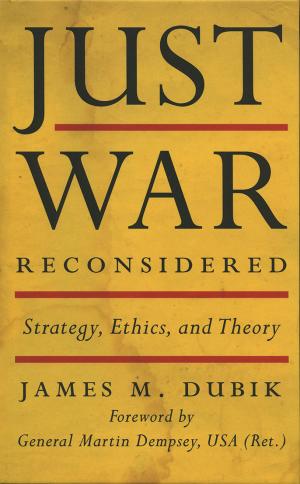November 2016 Book Reviews
November 2016 Book Reviews
Engaging Work Explores a War That’s ‘Endless’
How Everything Became War and the Military Became Everything: Tales from the Pentagon. Rosa Brooks. Simon & Schuster. 439 pages. $29.95
By Lt. Gen. Daniel P. Bolger
U.S. Army retired
There’s a great old cartoon depicting two disheveled, exhausted riflemen digging into rocky soil. The younger one looks particularly grumpy. “You’ll get over it, Joe,” says Willie. “Oncet I wuz gonna write a book exposin’ the army after th’ war myself.”
Willie and Joe’s creator, Sgt. Bill Mauldin of the 45th Infantry Division, did write that book, the wonderful Up Front. Willie and Joe didn’t exactly exhibit spit and polish but like Mauldin, they sure understood the dirty, deadly war they fought.
Rosa Brooks has followed in the worn boot prints of Mauldin and written an interesting book “exposin’” the Army—the present American military endeavor writ large—even though our current war is not over. Her account has a long title: How Everything Became War and the Military Became Everything: Tales from the Pentagon. But after all, it’s been a long war, with more to come.
Like Mauldin, Brooks knows the deal. She is the daughter of peace activists; a graduate of Harvard, Oxford and Yale; an accomplished attorney and human rights advocate; a Department of State consultant and decorated DoD official; and a faculty member at Georgetown University in Washington, D.C. She’s also been on the business end of an Iraqi insurgent’s weapon, and she’s the wife of a Special Forces officer. She has been right in the middle of this long, desultory, maddening conflict catalyzed by the horrific terrorist attacks of Sept. 11, 2001.
When I started reading Brooks’ book, I wanted to write her off as another well-credentialed Pentagon “suit”—even worse, a lawyer—long on theory and short on practice. Not another one, I thought.
I thought wrong. Having read this engaging work, I find her wholly credible, delightfully readable and quite convincing. Confounded by the vexations of today’s unwon conflict, she asks more questions than she answers. But that kind of deadly ambiguity is cooked into the vile, ill-defined nature of the sprawling mess we call war these days. Willie and Joe, meet Rosa. She’s spent a good bit of time in what passes for the foxholes of this irregular, all-embracing, endless war.
Brooks sees the problem as figuring out the boundary between war and peace. For Willie and Joe, it was easy. The guys enjoyed peace until Dec. 7, 1941. Then war descended in all its fury. And by Sept. 2, 1945, the gruesome hostilities ended in a formal surrender aboard the great gray battleship USS Missouri. War was an awful aberration, nasty, brutish and short—a few years. Afterward, peace returned.
For Brooks and our current generation, there have been no such bright lines. The war seemingly has been with us always and will be with us always: no surrenders, no victories, and no end. The current war, such as it is, started on 9/11. Or maybe it began in Kosovo, in 1999; or Bosnia, in 1995; or Somalia, in 1993; or with the first war against Iraq, in 1990–91.
Or perhaps you date it to 1983, when a terrorist truck bomber blew up our Marines in Beirut, Lebanon. You could say it started in 1979, when the Iranians took over our embassy in Tehran. You might well take it all the way back to the fall of the Ottoman Empire in 1918, or the conquest of Constantinople in 1453; or the Crusades, or the Romans, or even Cain and Abel. No matter; it’s an ancient struggle of West vs. East—or rather, Middle East.
Our enemies today cannot defeat us soldier-to-soldier and tank-to-tank. So they have chosen protracted war, insurgency, terrorism and propaganda, and it has thoroughly screwed us up. Brooks confronts that ugly reality head-on. This book is also her personal story, and it’s a really good one. She recounts her experiences in the Pentagon, Guantanamo, Kosovo, Iraq, Afghanistan, Uganda, Sierra Leone and various stateside military installations. She had been brought up to always give peace a chance and to distrust soldiers, the ones who made war. Yet she found herself sympathizing with the Willies, Joes and Janes she met. Soldiers, too, care about ideals bigger than themselves, enough to put their lives on the line.
The troops, of course, don’t pick their wars; far from it. So like ardent human rights advocate Brooks, those in uniform found themselves stuck squarely in what she rightly characterizes as “endless war” with “endless costs.” Concerned American citizens pay in daily frustrations, sleepless nights and squandered tax money. Soldiers pay in blood.
In her attempts to explore the shadowy borderlands of war and peace as both practitioner and scout, Brooks goes pretty far down the rabbit hole. She addresses all the hot issues: detentions, rules of engagement, drone strikes, nonlethal weaponry, secrecy, cyberwar, congressional oversight, presidential authority, “responsibility to protect,” the role of international organizations, and the importance of civil rights at home and abroad. She does so with wry humor and not a little self-deprecation. Brooks went to military detention centers, to see the working end of what made sense in climate-controlled Pentagon offices. She discussed the limits of war and peace at military educational institutions, seeing that soldiers young and old were just as confused as she was. She worked hard to get her ideas into key policy documents and made her case to some fairly high-ranking people in and out of uniform. All very diligent, all very urgent, all very proper, and all very much irrelevant—the unceasing war rolled on. When the dust cleared, she ended up right there with Willie and Joe and Jane, wondering what the hell just happened.
If you, too, wonder what happened since 9/11 and why, you will get a lot from this fine book from Brooks. As noted, she has many more questions than answers. In this age of war without end, that’s proof positive that she’s on the right track. When you finish her book, you will be, too.
Lt. Gen. Daniel P. Bolger, USA Ret., was the commander of Combined Security Transition Command-Afghanistan and NATO Training Mission-Afghanistan. Previously, he served as the deputy chief of staff, G-3/5/7, and as the commanding general, 1st Cavalry Division/commanding general, Multinational Division-Baghdad, Operation Iraqi Freedom. He holds a doctorate in Russian history from the University of Chicago and has published a number of books on military subjects. He is a senior fellow of the AUSA Institute of Land Warfare.
* * *
Finding Missing Pieces of an Age-Old Puzzle
Just War Reconsidered: Strategy, Ethics, and Theory. James M. Dubik. University Press of Kentucky (An AUSA Title). 236 pages. $50
By Col. Gregory Fontenot
U.S. Army retired
One of the best officers of his generation, retired Lt. Gen. James M. Dubik remains well-regarded as a thoughtful adviser on operations and a frequent contributor of well-argued essays in ARMY. Dubik has expanded his portfolio with Just War Reconsidered, in which he launches an expedition into the theory and practice of just war.
In the West, just war theory has its origins in theology, specifically that of St. Augustine of Hippo and later Saint Thomas Aquinas. At the beginning of the 17th century, Hugo Grotius made an important contribution to Western theory when he articulated the idea of a society of states with their relations conducted rationally and with some rules. The Peace of Westphalia embodied some of these principles and in large measure led to the system of international law on how war is waged today—at least, war as it is waged by Western nations.
Dubik’s foray into the ethics and philosophy of making war is important because as a practitioner, he brings insight not necessarily apparent to the academics who have dominated the field. To paraphrase Georges Clemenceau, war is too important for it to be left to theorists from academia. Moreover, in the West, contemporary just war theory is muddled because some confuse theory with their personal views of what is “good.” The responsibility to protect exemplifies the consequences of confusing good with just.
Dubik avoids such a pitfall by narrowing his assessment. He argues contemporary theory of justice in fighting war, or jus in bello, is inadequate because it addresses the tactical level of responsibility of soldiers without examining execution at the operational and strategic levels, where civilian authority and soldiers must collaborate.
Dubik compares execution in Vietnam and since 9/11 to execution in the Civil War, World War II and the First Gulf War. He claims these comparisons demonstrate the gap in theory. From this analysis, he deduces principles that, if followed, will ensure war is waged justly and, more to the point, successfully. These principles promote what he thinks of as “proper” collaboration between the civilian authority and its soldiers.
In assessing Dubik’s argument, it is essential to understand his motivation. As he puts it, because soldiers and their families “bear the final burden of war,” his aim is to “help increase the probability that their sacrifices will be made on behalf of better-thought-out aims, strategies and campaigns.” Dubik believes such a gap exists because of the necessarily unequal relationship between soldiers and those they advise. However, he argues that for the nation to succeed, a continuing and candid dialogue must occur between the civil authority and its soldiers.
Dubik believes that during the Vietnam War, President Lyndon B. Johnson and Secretary of Defense Robert McNamara lacked the ability and inclination “to conduct an adequate dialogue with their military leaders.” The dilemma of the Joint Chiefs of Staff and then-Army Chief of Staff Gen. Harold K. Johnson is an essential component of his argument. Early on, the Army chief had reservations about the U.S. commitment in Vietnam. When his advice was ignored, he considered resigning and holding a press conference to say why he had quit. In the end, he did not, nor did other service chiefs who considered protesting.
Harold Johnson came to regret his choice. Dubik believes he was right to have regrets and goes further, suggesting that officers have a responsibility to resign rather than execute or promote a policy with which they cannot abide.
This argument rejects the notion embodied in Samuel P. Huntington’s The Soldier and the State of objective civilian control of the military. Essential to this view, soldiers are obliged to obey all but illegal orders. Deciding or passing judgment on policy according to this view is out of bounds. Dubik’s view of the gap in jus in bello makes such objection not only permissible but also necessary if a proper dialogue is not occurring.
On the basis of his analysis, Dubik proposes five principles that will close the gap: continuous dialogue, final decision authority, managerial competence, legitimacy and resignation. Each of these deserves careful reading and consideration by soldiers and their civilian leaders. Each has merit.
Dubik argues that continuous dialogue ensures war aims remain linked “to the justification for going to war” in the first place. This is essential to preclude escalating war aims that would be excessive or would lengthen the period of conflict. As Dubik says, “Senior political leaders must be more than politically reliable, and senior military leaders must be more than good war fighters. To execute their jus in bello war-waging responsibilities, they must be competent leaders and managers, individually and collectively.”
Dubik’s provocative argument is fodder to continue the debate not only on civil-military relations but on how to wage war jus in bello at the tactical and strategic levels.
Col. Gregory Fontenot, USA Ret., commanded the 2nd Battalion, 34th Armor Regiment in Operation Desert Storm and the 1st Brigade, 1st Armored Division in Bosnia. He also served in the U.S. Army Training and Doctrine Command’s Command Planning Group; as director of the School of Advanced Military Studies; as commander of the then-Battle Command Training Program; and as director of the University of Foreign Military and Cultural Studies. An Army historian, he is co-author of On Point: The United States Army in Operation Iraqi Freedom.
* * *
How-To for Creating a Land Power Quickly
Forty-Seven Days: How Pershing’s Warriors Came of Age to Defeat the German Army in World War I. Mitchell Yockelson. New American Library Caliber. 390 pages. $28
By Lt. Col. James Jay Carafano
U.S. Army retired
In a harrowing ground campaign that contrasted with most of the great land battles of World War I, U.S. Army and Marine forces spearheaded an offense that broke the back of the German defenses in Western Europe. Lasting weeks, not months; crossing miles, not yards; the Battles of the Meuse-Argonne brought a quick end to a long and bloody conflict. In Forty-Seven Days: How Pershing’s Warriors Came of Age to Defeat the German Army in World War I, award-winning military historian Mitchell Yockelson has penned a breezy and engrossing overview of what happened after the doughboys went over there.
Yockelson, a history professor who has taught at both the U.S. Naval Academy and Norwich University, Vt., offers a solid introduction to the American military experience in the First World War. There are other books that deliver a deeper dive into U.S. combat operations. For example, David Woodward’s The American Army and the First World War offers comprehensive operational history, and Mark Ethan Grotelueschen’s The AEF Way of War: The American Army and Combat in World War I is a detailed examination of U.S. doctrine and the actual fighting methods that evolved on the ground. What Forty-Seven Days provides is an accessible and satisfying narrative of how the U.S. built, deployed and fought a million-man Army in less than two years—and won.
In addition to providing a combat narrative that takes the U.S. ground forces from their first big independent battle reducing the St. Mihiel salient to a blow-by-blow accounting of the Meuse-Argonne campaign, Yockelson brings to life the catalog of authentic leaders who ought not to be forgotten. The list starts with the commander of the American Expeditionary Forces (AEF), Gen. John “Black Jack” Pershing, to fighting commanders including Marine Corps Maj. Gen. John Lejeune and battlefield heroes such as then-Lt. Sam Woodfill; then-Maj. Charles Whittlesey, commander of the Lost Battalion; and Sgt. Alvin York.
Woven into the narrative of Forty-Seven Days are many little-known and underappreciated aspects of the doughboys’ war. Yockelson makes space to cover the role of the fledgling air component and air-ground operations. There is a brief account of the role of the all-black American units that fought on the front. The author adds vignettes on the role of intelligence, logistics, handling prisoners of war, dealing with the locals, and entertaining the troops. All of these additions remind the reader that war is more than just bombs and bayonets.
Perhaps what this book does best is inspire reflection on this question: If the U.S. had not fought in World War I, could it have ever mustered land power capable of winning in World War II? In many ways, the cauldron of strategic leadership for America’s second trip to save Europe was the bloody fields of France. The list of future great commanders shaped by their experiences in World War I starts with Gen. George C. Marshall Jr.
Pershing first met Marshall under the worst of circumstances. Marshall contradicted the commander of the AEF in public. Most assumed Marshall’s days were numbered. Instead, Pershing transferred Marshall to his staff, where he became perhaps the most important staff officer of the war. It was Marshall who designed the massive repositioning of U.S. ground forces and logistics that made the last great land campaign even possible. From that day on, no one ever doubted Marshall was one of the most capable and competent officers in uniform.
There were many other familiar names, great captains of World War II, who learned their trade in the Meuse-Argonne. The most famous, of course, were Gens. Douglas MacArthur and George S. Patton Jr.—both featured prominently in this book. There were, however, many distinguished corps and division commanders who served in World War II with notable combat records in World War I.
There are also a number of notable World War II commanders who never made it to the front. Then-Capt. Dwight D. Eisenhower didn’t get farther than Camp Colt in Pennsylvania, where he ran a mobilization depot. Then-Capt. Omar Bradley spent a good bit of the war battling strikebreakers at the Anaconda Copper Mine in Montana. Still, these men were mentored by World War I veterans. Eisenhower worked for Maj. Gen. Fox Conner and MacArthur. Bradley served after the war under Marshall.
But the significance of World War I for the Army was more than just assembling the future ranks of Marshall lieutenants and MacArthur men. The war was a laboratory for thinking about war. Commanding at the Infantry School after the war, Marshall directed and edited the influential text Infantry in Battle.
The war also taught the future leaders of the next war important lessons in mobilization; dealing with industry; and raising, training and leading an Army of citizen-soldiers. The U.S. military occupation of the Rhineland after the war even served as a model for the military organizing for the postwar occupations after World War II.
If America had not been forced to put a few million in uniform in 1917, it is interesting to speculate whether we could have marshaled, trained, equipped and commanded 12 million in 1944. This raises questions: What kind of leaders has the last decade of war produced? What kind of strategic leaders will they be in the future? While readers wait for that book, they can leaf through Forty-Seven Days and be introduced to a remarkable story about how America became a land power—in 47 days.
Lt. Col. James Jay Carafano, USA Ret., a 25-year Army veteran, is a Heritage Foundation vice president in charge of the think tank’s policy research in defense and foreign affairs.




